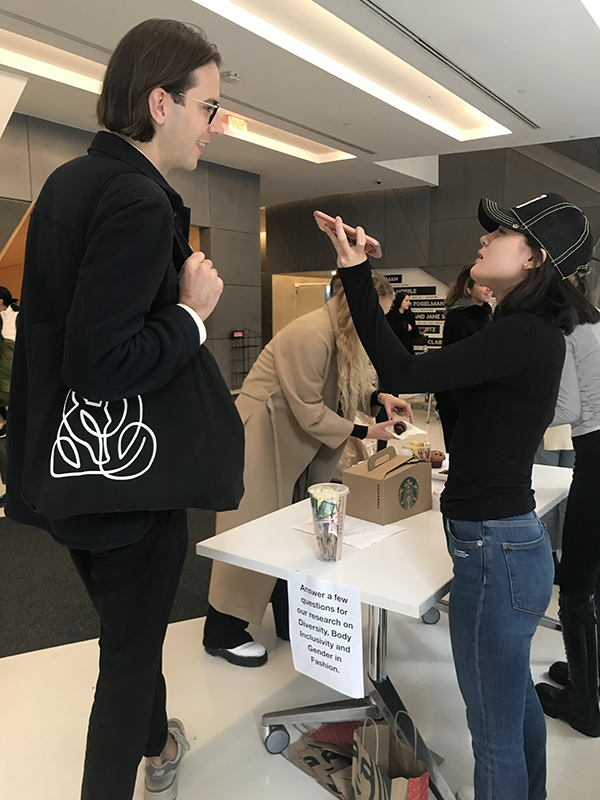
Kontoor Brands (Wrangler and Lee Jeans) partners with Parsons School of Design Students to Get Gen Z’s Insights into Body Positivity and Inclusivity
In 2019, when Kontoor Brands, the maker of Wrangler and Lee Jeans, decided to broaden its appeal, it partnered with Old Town Road singer Little Nas X on a limited-edition collection of T-shirts, denim jackets, jean shorts, and jeans. In October, the company opened a six-week pop-up at Fred Segal’s Los Angeles flagship to showcase a capsule collection featuring modern interpretations of archival pieces from four pivotal periods in the brand’s history.
In a further attempt to bolster its image and broaden its reach beyond Middle America, Kontoor partnered last semester with design students from The New School’s Parsons School of Design. The goal was to tap into a New York–based Gen Z sensibility to increase brand desirability in general and to find ways to appeal more to plus-size women, younger people, and over 55- year old consumers.
Students in a class called Research Collaboration on Diversity and Body Positivity’ served as on-the-ground design strategists to the company, offering long-range actionable insights, conducting on-site interviews, analyzing research, and creating reports. The students, divided into teams of two, explored ways Kontoor could better embrace and communicate inclusivity throughout the customer experience. The students analyzed the plus-size retail experience, aging and the over-55 consumer in fashion, gender representation in fashion, and Asian-American consumerism and identity. Kontoor will decide whether to apply the findings in its long-term strategies.
Increasingly, companies are coming to Parsons students to consult on design strategy. The students in the Kontoor partnership helped clarify questions the company is interested in examining more closely, including how fashion brands can better embrace and communicate body inclusivity in the plus-size customer retail experience, Another section of a related class, taught by Hala Abdul Malek, an assistant professor of strategic design and management, partnered with E. & J. Gallo Winery, providing comprehensive research into multiple aspects of health and wellness.
“Often the most exciting collaborations happen when our students engage with companies that aren’t on their daily social media feed,” says Jeongki Lim, the director of Parsons’ Strategic Design and Management Bachelor of Business Administration program. “In today’s creative economy, the value of design is universal. The companies may not be making headlines every year, but are creating tangible impact every day. They are the ones that resonate the most with the new generation of creative professionals.”
Design students Isabela Pak and Katie Choi conducted research on the plus-size retail experience at Macy’s, Burlington Coat Factory, Nordstrom’s, and Bergdorf Goodman in Manhattan. They discovered at one store that the plus-size department was relegated to the back corner of the seventh floor and located, perhaps not coincidentally, next to the in-store McDonald’s and Carvel.
Through their fieldwork and interviews with more than 100 women who identified themselves as plus size, the students learned that 96 percent of plus-size customers say that poor fit is their No. 1 complaint. Eighty-five percent want to retire the term “plus size”; 92 percent prefer “inclusive sizing” over “plus size.” Eighty-nine percent feel that plus size sections are segregated from the rest of the store (one woman complained that plus size is frequently displayed next to maternity clothing). Salespeople in the plus-size section were described as “rude, intimidating and unprofessional.”
Dylan Zack and Riwa Sabri, who researched the aging and over-55 consumer, learned that 70 percent of all U.S. income is in the hands of those 55 years and older but only 5 percent of all advertising is directed at the 50-and-older crowd. Seventy percent of the women in the mature market in North America feel ignored by the fashion and beauty market.
One of the many interesting trends they discovered was the use of multigenerational advertisements. “We found that brands such as Nike and Magnum that are decidedly using older models in their recent campaigns are actually attracting a younger audience that wants to see more everyday brands use this tactic,” they write in their final report. Th students found that both younger and older consumers responded extremely positively to images of vibrant, fashionable older models in ads that “emphasize the mind,” as they see these figures as aspirational.
“It was a unique opportunity for a brand to gather fresh research and insights from a Gen Z perspective” says Monica Belot, a Parsons adjunct professor of Strategic Design and Management, who taught the Kontoor-partnered class.
“The students went beyond providing business insights to also demonstrate how embracing truly progressive and inclusive practices has a market value, and will ultimately prove to be highly beneficial to a company’s bottom line. The biggest part of our research plays a huge role in opening up the eyes and minds of our partners. It’s a very New School approach.”